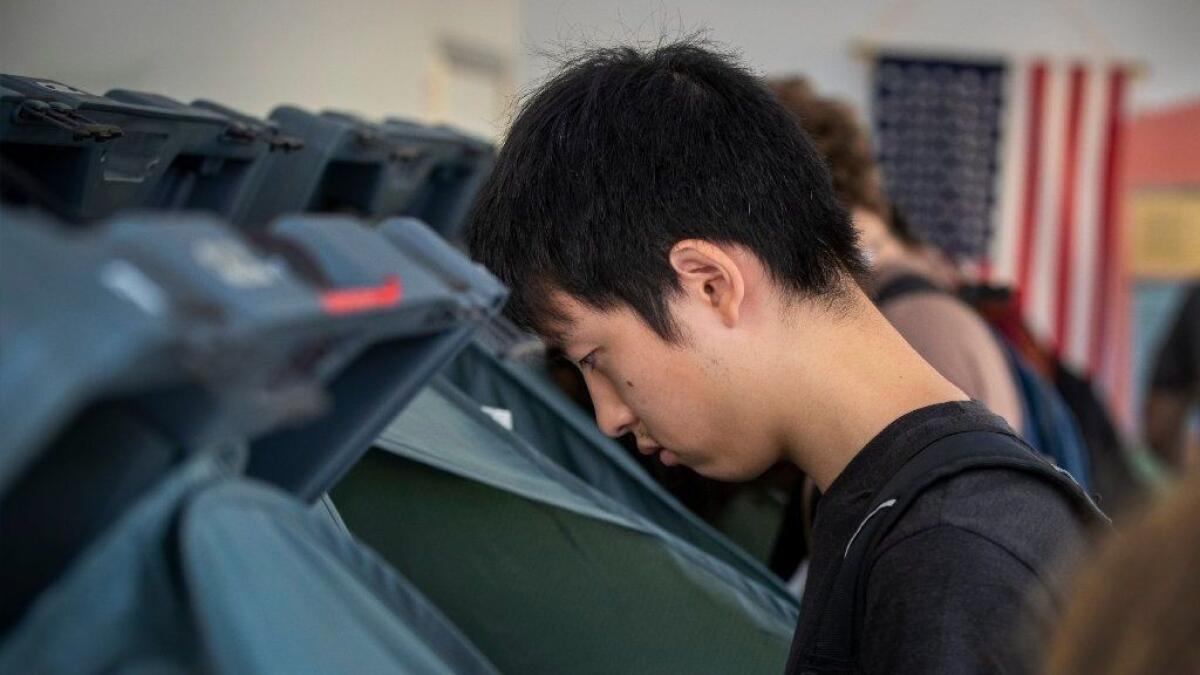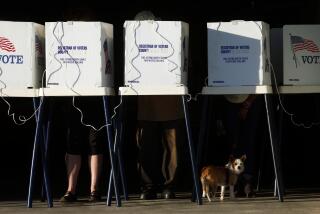Voters are already streaming to polls in record numbers, with both sides seeking clues on outcome

Reporting from Washington — Voters across the country have been crowding into polling places and mailing in ballots in numbers rarely seen in an off-year election, pointing toward a possible record turnout for Tuesday’s contest and leaving operatives from across the political spectrum trying to read tea leaves to figure out what it means.
In some states, more people are on track to cast ballots in early voting than in the entire election in 2014. In Texas, one such state, hundreds of thousands of new voters have already participated. Democrats hope that surge indicates that their Senate candidate, Beto O’Rourke, may be succeeding in mobilizing a crucial demographic.
But Republicans are also energized, turning out in larger numbers than Democrats so far in Florida, for example, where a cliffhanger of a race for governor features a Trump acolyte competing against an unabashed progressive who would be the state’s first African American governor.
The picture in California so far is more status quo. The state has at least a half dozen hotly contested congressional districts, which could play a big role in whether Democrats take back a majority in the House. But in the rest of the state, the lack of a close race at the top of ticket is holding down turnout, said Paul Mitchell, vice president of Political Data, which compiles voter data in the state.
California was one of the country’s pioneers in widespread early voting, and at this point, a large majority of voters get their ballots in the mail and either send them back or drop them at a polling station. Some 3 million ballots had been cast in the state by Friday.
Nationwide, as early voting was coming to a close in many states on Friday, more than 30 million ballots had already been cast. Turnout is hitting a pace closer to what’s typically seen in presidential elections. It has the potential to be the highest in an off-year election since 1966.
“When you look at some of these states, the numbers are eye-popping,” said Michael McDonald, a political science professor at the University of Florida and one of the country’s leading experts on voting patterns.
Midterm elections typically draw far fewer voters than presidential contests. In 2016, about 60% of voting-eligible Americans cast ballots, according to McDonald’s compilations of state data. In 2014, only 37% voted — the lowest turnout in years. The trends so far indicate that close to half of those eligible will vote this time, McDonald estimates.
Because Democrats rely heavily on the votes of younger people and minorities, who are less consistent in their voting than are older whites, their candidates usually benefit from a higher turnout.
As a result, Democrats hope that the numbers so far point to their much-ballyhooed blue wave, but they are reluctant to say as much. Misinterpretation of early voting trends in 2016 helped land a lot of egg on a lot of faces after Donald Trump’s surprise victory.
Early voting figures can easily mislead. States release a trove of data about who the voters are — information on their party affiliations, voting history, age and so on. But no one knows for which candidate those voters cast a ballot. Nor can anyone be sure whether people who vote early are simply the same voters who would have otherwise shown up on Tuesday.
In Texas, both O’Rourke and incumbent Sen. Ted Cruz suggested the state’s huge early turnout would boost their campaigns. Texas is still a deeply conservative place, and more voters coming to the polls can only mean more support for him, Cruz suggested in a CBS “60 Minutes” segment released Friday.
O’Rourke said much the same on the show: “The more people who show up, the better we do.”
The results Tuesday will reveal who is right. But one thing is clear: The numbers already are Texas-sized.
If current trends hold, some 3 million more people will vote this year in Texas than did during the last midterm, in 2014, said Tom Bonier, CEO of TargetSmart, a Democratic data firm closely tracking early voting.
“That’s amazing,” Bonier said.
The state is also drawing first-time voters to the polls. Already, Bonier said, more than 300,000 people who were eligible to vote in the 2016 presidential election but did not show up that year have cast ballots in Texas.
“Texas is leading the way by a long shot in first-time voting,” Bonier said. “It is not nearly as much a factor in other states.”
In California’s seven most competitive districts — all currently held by Republicans — registered GOP voters have returned ballots at a slightly higher clip than registered Democrats. Of the approximately 530,000 ballots returned, almost 193,000 came from registered Republicans, compared with 177,000 from registered Democrats, according to Political Data.
How that translates into votes, however, remains a big question. Democrats expect to pick up votes in suburban districts from a significant number of Republicans whose party affiliation does not signal loyalty or approval of President Trump.
Turnout is trending highest in the four competitive House districts in Orange County and north Los Angeles County. And there has been an uptick in younger, independent voters in coastal counties who didn’t participate in the primary. That’s likely a good sign for Democrats, Mitchell said. Such voters tend to be progressive.
California is not the only state where younger voters are hitting the polls in force. In Georgia, voters younger than 30 have been casting early ballots at quadruple the rate they did in 2014. In Texas and Nevada, voting by young people is up five fold. The rate is triple in Arizona, according to TargetSmart.
In Nevada, Democrats have built a small but persistent statewide lead in early votes, said Jon Ralston of the Nevada Independent, who closely tracks the state’s vote.
Some bellwether districts in the Midwest also have provided encouraging signs for Democrats. One is Iowa’s 1st Congressional District, located in a swing region where voting analysts first started to notice a migration toward the GOP as early ballots were cast during the 2016 campaign.
Now, registered Democrats are showing back up in force. The party balance is 10 points more favorable to the Democrats than it was at this point in 2016, McDonald said.
“These are huge changes,” McDonald said. “It signals enthusiasm among Democrats and that Republicans are not as engaged in these key swing districts they will need.”
The shift evident in early voting patterns in such districts could have broader implications for several competitive governors races in the Midwest, where Democrats are mounting strong challenges in states currently controlled by Republicans, McDonald added.
But he noted that in other parts of the country, Republicans are making a strong showing of their own.
In Florida, for example, registered Republicans continued to edge out Democrats in early voting through Friday. The trend is consistent with Florida’s early voting patterns from past years, and Democratic vote counters point out that the GOP advantage has shrunk compared with 2014.
Overall, the most either side can tell is what has consistently been true of Florida since 2000: The statewide contests are likely to be very close.
Halper reported from Washington, Sweedler from Los Angeles.
The latest look at the Trump administration and the rest of Washington »
More stories from Evan Halper »
[email protected] | Twitter: @evanhalper
[email protected] | Twitter: @mayasweedler
More to Read
Get the L.A. Times Politics newsletter
Deeply reported insights into legislation, politics and policy from Sacramento, Washington and beyond. In your inbox three times per week.
You may occasionally receive promotional content from the Los Angeles Times.











